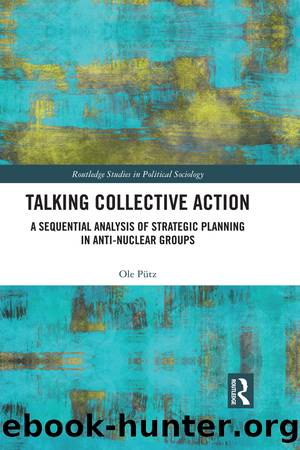Talking Collective Action by Ole Pütz

Author:Ole Pütz [Pütz, Ole]
Language: eng
Format: epub
Tags: Social Science, General, Sociology
ISBN: 9780429627071
Google: TRGjDwAAQBAJ
Publisher: Routledge
Published: 2019-07-17T04:57:38+00:00
07 Anna: But there w[ere] more.
08 Erika: [hm?]
09 Stefan: It was said seven thousand.
10 Anna: Yes.
11 Erika: Right [and it was said (0.6) seven thousand.]
12 Carol: [It was the biggest one, seven thousand-]
13 Erika: But there were by no chance seven thousand.
14 Carol: eh::[hehehe]
15 Erika: [Doesnât] really matte[r.]
16 Markus: [he] [he]he[hehe]hehehehehe
17 Carol: [hehe]
18 Sarah: It does. âit does
19 Anna: ehhe[he]
20 Carol: [he]hehehe
21 David: You have to firmly [believe.]
Anna and Stefan also attended the rally. Both challenge Erikaâs estimate and make it clear that her negative assessment is not shared by the group. Anna argues, âbut there were moreâ (l. 7), clearly disagreeing with Erika (l. 7). Stefanâs turn, âit was said seven thousandâ (l. 9), is more ambivalent because the passive voice he uses leaves open which number Stefan believes to be more accurate. Annaâs disagreement and Stefanâs more ambivalent reaction set the stage for a conflict (see Chapter 5.3). In order to constitute a conflict, Erika would now have to insist on her estimate or disagree with Anna or Stefan in another form. To avoid a conflict, Erika could modify or correct her previous statement or change the topic. Erikaâs response is equivocal: She agrees with Stefan at first (l. 11), but this turns out to be a token agreement. Erika uses the same words Stefan used, âright and it was said (0.6) seven thousandâ (l. 11), including the passive voice, and then adds, âbut there were by no chance seven thousandâ (l. 13). While Stefan uses a passive voice formulation to mitigate the potential for disagreement that follows from his statement, Erika uses the same formulation to highlight the difference between what âwas saidâ and what âactually happened,â suggesting that what âwas saidâ may not be true. Erika is now in disagreement with Annaâs earlier statement, which constitutes a conflict, and she also rejects Stefanâs number (l. 9). As we may expect from the previous analyses, the emerging conflict does not continue, and the potential tension that such a conflict could produce is immediately resolved. As soon as Erika states her disbelief in the number seven thousand, Carol begins to laugh (l. 14) and Markus joins in (l. 16). Laughter frames Erikaâs disagreement with Anna and Stefan as a laughable matter that is not of serious import, an effect frequently associated with laughter (Emerson 1969; Holt 2013; McKinlay & McVittie 2006; Norrick & Spitz 2008). Erika actively participates in mitigating her disagreement by saying that it âdoesnât really matterâ (l. 15) next, thereby implying that the true number of participants is nothing worth arguing about, although she initiated the topic in the first place.2
So far, participants have not reached a collective assessment of the rally because they did not agree on one. Because participants reject Erikaâs negative assessment, they cannot conclude that the low participation Erika observed constitutes a problem that requires tactical revision, as AANP did for the case of the demonstration. In fact, the activists from EXIT do the opposite and argue that the rally was
Download
This site does not store any files on its server. We only index and link to content provided by other sites. Please contact the content providers to delete copyright contents if any and email us, we'll remove relevant links or contents immediately.
| Automotive | Engineering |
| Transportation |
Whiskies Galore by Ian Buxton(41937)
Introduction to Aircraft Design (Cambridge Aerospace Series) by John P. Fielding(33092)
Small Unmanned Fixed-wing Aircraft Design by Andrew J. Keane Andras Sobester James P. Scanlan & András Sóbester & James P. Scanlan(32763)
Craft Beer for the Homebrewer by Michael Agnew(18196)
Turbulence by E. J. Noyes(7977)
The Complete Stick Figure Physics Tutorials by Allen Sarah(7336)
Kaplan MCAT General Chemistry Review by Kaplan(6899)
The Thirst by Nesbo Jo(6877)
Bad Blood by John Carreyrou(6581)
Modelling of Convective Heat and Mass Transfer in Rotating Flows by Igor V. Shevchuk(6406)
Learning SQL by Alan Beaulieu(6237)
Weapons of Math Destruction by Cathy O'Neil(6214)
Man-made Catastrophes and Risk Information Concealment by Dmitry Chernov & Didier Sornette(5956)
Digital Minimalism by Cal Newport;(5704)
Life 3.0: Being Human in the Age of Artificial Intelligence by Tegmark Max(5512)
iGen by Jean M. Twenge(5384)
Secrets of Antigravity Propulsion: Tesla, UFOs, and Classified Aerospace Technology by Ph.D. Paul A. Laviolette(5332)
Design of Trajectory Optimization Approach for Space Maneuver Vehicle Skip Entry Problems by Runqi Chai & Al Savvaris & Antonios Tsourdos & Senchun Chai(5037)
Pale Blue Dot by Carl Sagan(4953)
